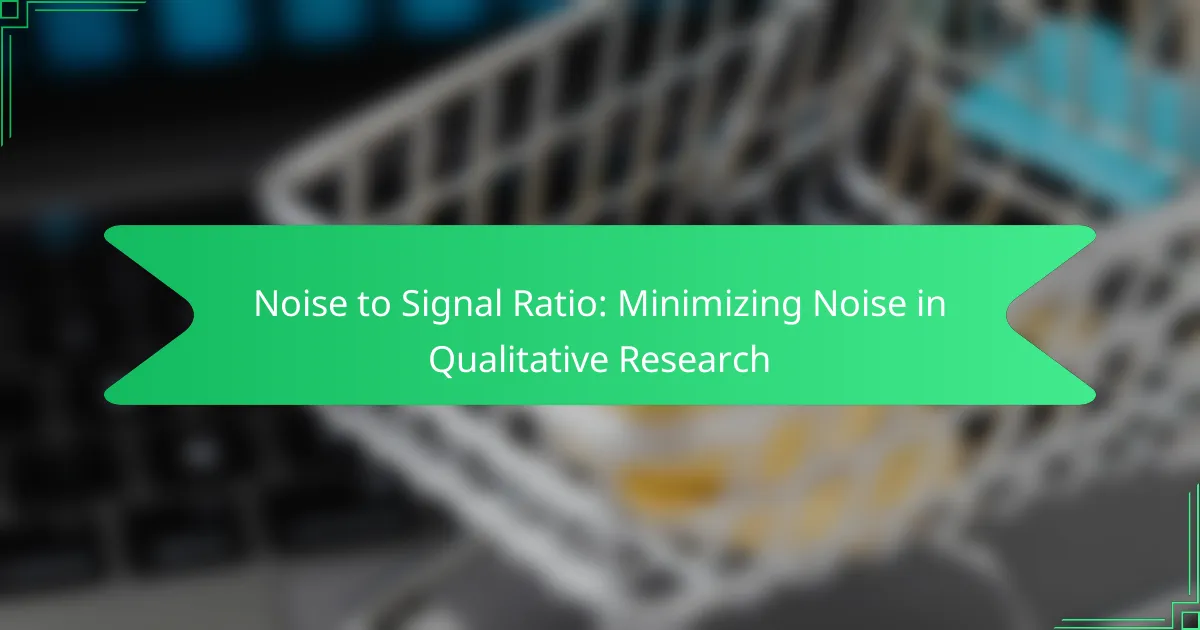The noise to signal ratio (NSR) is a critical metric in data collection that measures the clarity of relevant information against background noise. Effective methods for improving NSR are essential, as they enhance the reliability of insights and support better decision-making by minimizing the impact of irrelevant data. By employing strategies such as data cleaning and advanced analytics, organizations can significantly improve the quality of their data and the accuracy of their analyses.

What are effective data collection methods for noise to signal ratio?
Effective data collection methods for noise to signal ratio (NSR) include a variety of techniques that help quantify the clarity of data against background noise. These methods facilitate the gathering of relevant information while minimizing irrelevant data that can distort analysis.
Surveys and questionnaires
Surveys and questionnaires are direct methods for collecting data on perceptions and experiences related to noise and signal quality. They can be designed to target specific demographics, allowing for tailored questions that yield valuable insights.
When creating surveys, consider using a mix of closed and open-ended questions to capture both quantitative and qualitative data. Aim for a sample size that reflects the population to ensure the results are statistically significant.
Automated data logging
Automated data logging involves using sensors and software to continuously record data without human intervention. This method is particularly effective for monitoring environmental noise levels and signal strength over time.
Key considerations include the calibration of equipment and the frequency of data collection. Ensure that the logging system is capable of capturing data at intervals that are relevant to the analysis, such as every few seconds for dynamic environments.
Focus groups
Focus groups gather qualitative data through guided discussions among a selected group of participants. This method allows for in-depth exploration of opinions and experiences regarding noise and signal issues.
When conducting focus groups, select participants who represent a cross-section of the target audience. Facilitate discussions to uncover insights that might not emerge from surveys, but be cautious of groupthink influencing individual responses.
Observational studies
Observational studies involve systematically watching and recording behaviors or events in their natural context. This method is useful for assessing real-world noise impacts and signal clarity without interference.
To conduct effective observational studies, develop a clear protocol for what to observe and how to document findings. Consider factors like time of day and environmental conditions, as these can significantly affect noise levels and signal quality.
Web scraping techniques
Web scraping techniques involve extracting data from websites to analyze trends and patterns related to noise and signal. This method can provide large datasets quickly, but it requires careful consideration of legal and ethical guidelines.
Ensure compliance with website terms of service and data privacy regulations when scraping. Use tools that allow for efficient data extraction and consider the need for data cleaning to filter out noise from the collected information.

How does noise to signal ratio impact data analysis?
The noise to signal ratio (NSR) significantly affects data analysis by influencing the clarity and reliability of the insights drawn from data. A high level of noise can obscure meaningful signals, leading to inaccurate conclusions and poor decision-making.
Influences decision-making accuracy
A high noise to signal ratio can lead to erroneous decisions, as it becomes challenging to distinguish between relevant data and irrelevant fluctuations. For instance, in financial markets, excessive noise can cause traders to misinterpret trends, resulting in costly investment mistakes.
To enhance decision-making accuracy, focus on improving data quality by filtering out noise through techniques such as data smoothing or using robust statistical methods. Regularly assess the NSR to ensure that the data being analyzed remains reliable.
Affects data interpretation
The interpretation of data is heavily influenced by the noise to signal ratio, as high noise levels can lead to misinterpretation of results. Analysts may draw incorrect conclusions if they cannot identify the true signals within the data.
To mitigate this issue, utilize visualization tools that help highlight significant trends while minimizing noise. Employing techniques like outlier detection can also aid in refining the data set for clearer interpretation.
Impacts resource allocation
Noise to signal ratio can significantly impact how resources are allocated within an organization. When data is clouded by noise, resources may be misallocated based on inaccurate insights, leading to inefficiencies.
To optimize resource allocation, organizations should prioritize data collection methods that reduce noise, such as using high-quality sensors or employing advanced data analytics. Regularly reviewing and adjusting strategies based on NSR can help ensure that resources are directed towards the most impactful areas.

What are the best practices for improving noise to signal ratio?
Improving the noise to signal ratio involves implementing strategies that enhance the quality of data while minimizing irrelevant or extraneous information. Key practices include data cleaning, utilizing advanced analytics tools, and implementing robust sampling methods.
Data cleaning techniques
Data cleaning is essential for enhancing the noise to signal ratio by removing inaccuracies and inconsistencies from datasets. Techniques include identifying and correcting errors, removing duplicates, and standardizing data formats. For instance, ensuring that all date entries follow a consistent format can significantly reduce confusion and improve analysis.
Another effective method is outlier detection, which involves identifying and addressing data points that deviate significantly from the norm. This can be done through statistical methods or visualization tools, helping to ensure that the remaining data accurately reflects the intended signal.
Utilizing advanced analytics tools
Advanced analytics tools can significantly enhance the noise to signal ratio by applying sophisticated algorithms to filter and analyze data. Machine learning models, for example, can learn to distinguish between relevant signals and background noise, improving predictive accuracy. Tools like Python’s Pandas or R’s dplyr can automate this process, making it easier to manage large datasets.
Additionally, visualization tools can help identify patterns and anomalies in data, allowing analysts to focus on the most relevant information. Using dashboards that highlight key performance indicators can streamline decision-making and reduce the impact of noise.
Implementing robust sampling methods
Robust sampling methods are crucial for enhancing the noise to signal ratio by ensuring that the data collected is representative of the population being studied. Techniques such as stratified sampling can help ensure that different segments of the population are adequately represented, reducing bias and improving the quality of insights drawn from the data.
It’s also important to determine an appropriate sample size, as too small a sample may lead to unreliable results while too large a sample can introduce unnecessary complexity. Aiming for a sample size that balances these factors—typically in the range of hundreds to thousands, depending on the study’s goals—can help achieve a clearer signal amidst the noise.

What criteria should be considered when selecting data collection methods?
When selecting data collection methods, it’s essential to consider factors such as the target audience, the type and volume of data needed, and budget constraints. Each criterion influences the effectiveness and efficiency of the data collection process.
Target audience characteristics
Understanding the characteristics of your target audience is crucial for choosing appropriate data collection methods. Consider demographics such as age, education level, and technological proficiency, as these factors can affect how respondents engage with surveys or interviews.
For example, younger audiences may prefer online surveys, while older individuals might respond better to phone interviews. Tailoring your approach to the audience can enhance response rates and data quality.
Data type and volume
The type and volume of data you need will significantly influence your choice of data collection methods. Qualitative data, such as opinions and experiences, may be best gathered through interviews or focus groups, while quantitative data often requires structured surveys or experiments.
Additionally, consider the volume of data you aim to collect. For larger datasets, automated online surveys can be more efficient, while smaller, in-depth studies might benefit from direct interactions with participants.
Budget constraints
Budget constraints play a vital role in determining which data collection methods are feasible. Some methods, like online surveys, can be cost-effective, while others, such as in-person interviews, may require significant resources for travel and personnel.
It’s important to balance cost with the quality of data needed. Prioritize methods that provide the best return on investment, ensuring that the data collected meets your research objectives without overspending.

How can organizations evaluate the effectiveness of their data collection methods?
Organizations can evaluate the effectiveness of their data collection methods by analyzing the quality, relevance, and accuracy of the data gathered. This involves assessing how well the methods align with organizational goals and the impact of the data on decision-making processes.
Performance metrics analysis
Performance metrics analysis involves examining specific indicators that reflect the efficiency and effectiveness of data collection methods. Key metrics may include response rates, data accuracy, and the time taken to collect and process data. Organizations should establish benchmarks to compare these metrics against industry standards.
To conduct a thorough performance metrics analysis, organizations can utilize tools such as dashboards or data visualization software. These tools can help track metrics over time, allowing for trend analysis and identification of areas needing improvement. For instance, if response rates are consistently low, it may indicate a need to refine the data collection approach.
Common pitfalls in performance metrics analysis include focusing solely on quantitative data without considering qualitative insights. Organizations should balance numerical metrics with feedback from data collectors and users to gain a comprehensive understanding of the effectiveness of their methods. Regular reviews and adjustments based on these insights can enhance overall data collection strategies.










